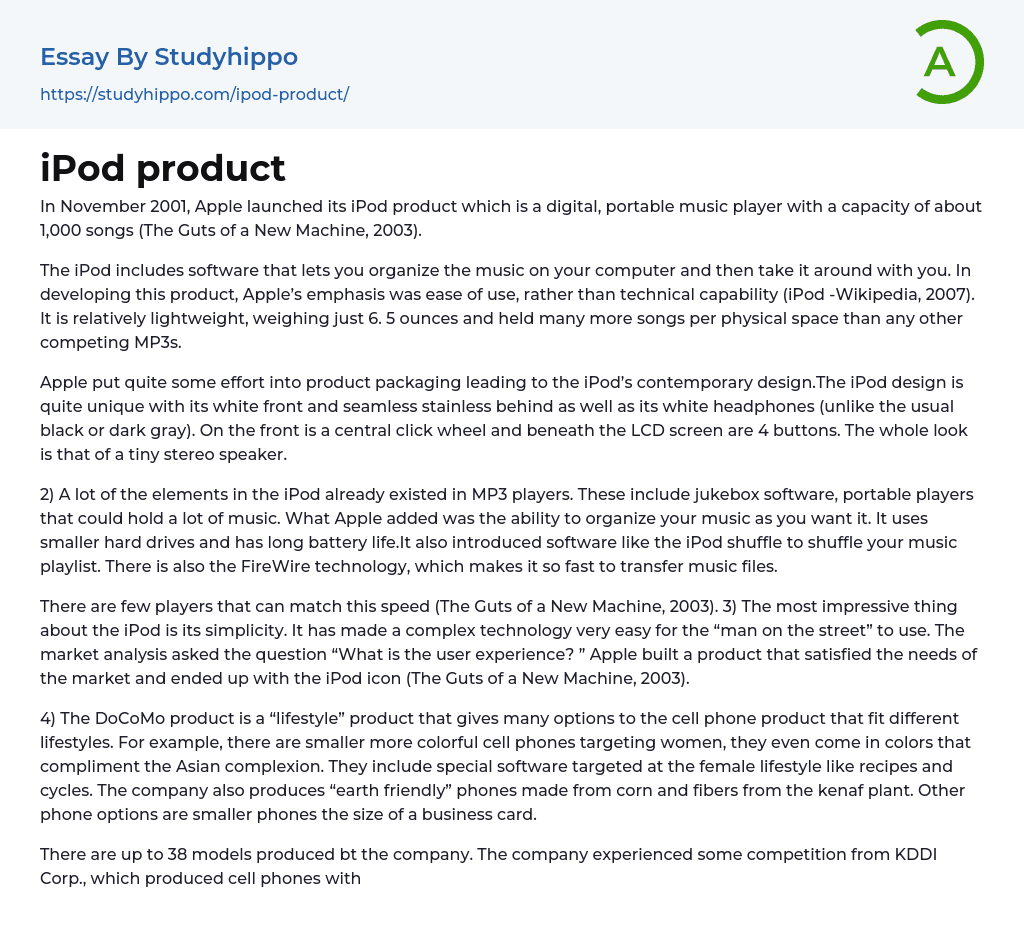Apple introduced the iPod in November of 2001. The iPod is a portable digital music player that can store around 1,000 songs (The Guts of a New Machine, 2003).
Apple prioritized ease of use over technical capability when developing the iPod which comes equipped with software for organizing computer music that can be taken on the go. In comparison to competing MP3s, the iPod weighs just 6.5 ounces yet stores a greater number of songs per physical space.
Apple invested significant effort into the packaging of their product, resulting in the distinctive design of the iPod. This design includes a white front, seamless stainless steel back, and white headphones (unusual compared to the typical black or gray). The front features a central click wheel and beneath the LCD screen are four buttons, resulting in an overall appearance similar to that of a miniature stereo speaker.<
.../p>
2) While many MP3 players already had features such as jukebox software, ample storage, and portability, Apple's iPod differentiated itself with advanced capabilities for personalizing and arranging music. Additionally, the iPod's smaller hard drives and extended battery life set it apart. Apple also introduced unique software like the iPod shuffle for randomized music playback, as well as the use of FireWire technology to facilitate quick file transfers.
The iPod's speed is unmatched by most players, as stated in The Guts of a New Machine (2003). Its simplicity has made complex technology accessible to the average person, making it a remarkable feature. Apple successfully met the market's needs by prioritizing user experience, resulting in the iconic iPod.
DoCoMo provides a variety of cell phones to suit different lifestyles. The "lifestyle" line is tailored to mee
the diverse requirements of its users, including compact and vividly colored phones aimed at women with shades that complement Asian skin tones. These models also provide user-specific software, such as menstrual cycle tracking and recipe features. DoCoMo also offers environmentally-friendly options made from corn and kenaf plant fibers. Additionally, the company produces pocket-sized phones that are as small as business cards.
According to Japan’s New Phones (2006), the company has produced a total of 38 models. Although facing competition from KDDI Corp., whose phones feature glossy exteriors and shiny tile-like keypads, the standout feature of DoCoMo’s products is their customer focus. They have designed simpler devices that cater to individual personalities, resulting in phones tailored for seniors with enhanced usability features like larger buttons, louder volume settings, and screen fonts.
According to Japan's New Phones in 2006, this product is not only easy for older people to use but also environmentally conscious and friendly.
- Brand Equity essays
- Branding essays
- Nike, Inc. essays
- Market share essays
- Razor essays
- Bankruptcy essays
- Earnings essays
- Tata Group essays
- S corporation essays
- Secretary essays
- Premise essays
- Computer File essays
- Desktop Computer essays
- Servers essays
- Photo Equipment essays
- Video Game Console essays
- Computer Components essays
- Personal Computer essays
- Computer Peripherals essays
- Flowchart essays
- Integrated Circuit essays
- Tracking system essays
- Hard Disk Drive essays
- Advertising essays
- Audience Theory essays
- Competitor Analysis essays
- Consumer essays
- Marketing Management essays
- Marketing Mix essays
- Marketing Plan essays
- Marketing Research essays
- Marketing Strategy essays
- Point Of Sale essays
- Price essays
- Procurement essays
- Product essays
- Product Differentiation essays
- Promotion essays
- Promotion And Marketing Communications essays
- Retailing essays
- Trademark essays
- Anheuser-busch essays
- Brands essays
- Detergent essays
- Product Placement essays
- Research Design essays
- New Product Development essays
- Advertisement essays
- Brand essays
- Sales Promotion essays




